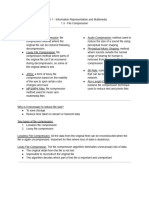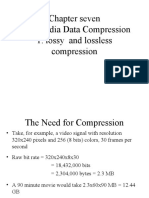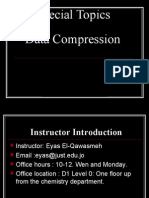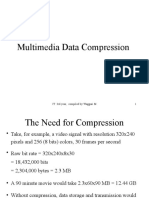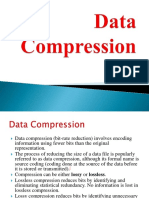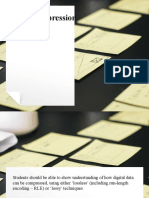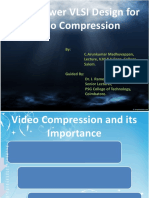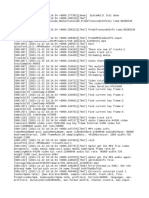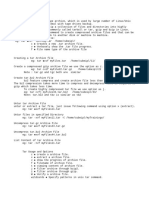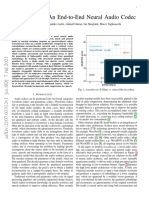Cambridge (CIE) A Level Your notes
Computer Science
Compression
Contents
Compression
Compression Techniques
© 2025 Save My Exams, Ltd. Get more and ace your exams at savemyexams.com 1
� Compression
Your notes
The need for compression
What is compression?
Compression is reducing the the size of a file so that it takes up less space on
secondary storage
There are scenarios where compression may be needed, such as:
Maximise the amount of data you can store on a digital device such as a mobile
phone or tablet
Minimise the transfer time of data being uploaded, downloaded or streamed
across a network such as the Internet
Compression can be achieved using two methods, lossy and lossless
Lossy vs lossless
What is lossy compression?
Lossy compression is when data is lost in order to reduce the size on secondary storage
Lossy compression is irreversible
Lossy can greatly reduce the size of a file but at the expense of losing quality
Lossy is only suitable for data where reducing quality is acceptable, for example
images, video and sound
In photographs, lossy compression will try to group similar colours together, reducing
the amount of colours in the image without compromising the overall quality of the
image
© 2025 Save My Exams, Ltd. Get more and ace your exams at savemyexams.com 2
� Your notes
© 2025 Save My Exams, Ltd. Get more and ace your exams at savemyexams.com 3
� Your notes
In the images above, lossy compression is applied to a photograph and dramatically
reduces the file size
Data has been removed and the overall quality has been reduced, however it is
acceptable as it is difficult to visually see a difference
Lossy compressed photographs take up less storage space which means you can store
more and they are quicker to share across a network
What is lossless compression?
Lossless compression is when data is encoded in order to reduce the size on secondary
storage
Lossless compression is reversible, the file can be returned to its original state
Lossless can reduce the size of a file but not as dramatically as lossy
Lossless can be used on all data but is more suitable for data where a loss in quality is
unacceptable, for example documents
In a document, lossless compression uses algorithms to analyse the contents looking
for patterns and repetition
© 2025 Save My Exams, Ltd. Get more and ace your exams at savemyexams.com 4
� Your notes
In the image above, lossless compression is automatically applied to document
formats such as DOCX and PDF with a different rate of success
When you open a lossless compressed document the decompression process
reverses the algorithms and returns the data back to its original state
Lossless compressed documents take up less storage space which means you can
store more and they are quicker to share across a network
© 2025 Save My Exams, Ltd. Get more and ace your exams at savemyexams.com 5
� Compression Techniques
Your notes
File compression
MPEG-3 (MP3) - Audio compression
MP3 uses audio compression to reduce file size
A typical music file can be reduced by up to 90% (e.g. 80 MB to 8 MB)
MP3 files are used on:
MP3 players
Computers
Smart phones
Music can be:
Downloaded or streamed from the internet
Converted from a CD to MP3 format
MP3 quality isn’t as high as the original CD, but it’s good enough for most people
MP3 uses perceptual music shaping to remove sounds we don’t notice:
Frequencies outside human hearing range
Quieter sounds that are masked by louder ones
This makes the file smaller without a big drop in quality
MP3 is a lossy format:
Some original data is permanently lost
You can’t get the original file back
MPEG-4 (MP4) - Multimedia file format
MP4 is similar to MP3, but stores more than just audio
It can store:
Music
Videos
Photos
Animations
Commonly used for streaming videos over the internet
MP4 uses compression to keep file size small
© 2025 Save My Exams, Ltd. Get more and ace your exams at savemyexams.com 6
� Maintains high quality without noticeable loss to the viewer
Images Your notes
Bitmap images can be compressed, the file size and quality are reduced
JPEG is the most common file format for bitmap images
The JPEG compression algorithm creates a new file, so the original file can no longer be
used
Vector graphics can also be compressed but with limited success
Scalable vector graphics (.svg) use an XML text file which means that allows them to be
compressed.
Run-length encoding (RLE)
What is run-length encoding?
Run-length encoding (RLE) is a form of data compression that condenses identical
elements into a single value with a count
Text data
For text data containing the string "AAAABBBCCDAA", the plain RLE encoding would be
"4A3B2C1D2A"
The string has:
four 'A's (4A)
three 'B's (3B)
two 'C's (2C)
one 'D' (1D)
two 'A's (2A)
To represent this in binary, the count is stored in a fixed size binary format (e.g. 7 or 8
bits)
The character is stored using its ASCII value (7 bits)
The binary RLE representation of 4A would be 0000100 1000001
0000100 - binary for the count (4)
1000001 - binary for 'A' (65)
Images
Run-length encoding (RLE) uses frequency/data pairs to compress bitmap image data
For example, the following bitmap image with a bit depth of 1 bit would have the
following binary bit pattern
© 2025 Save My Exams, Ltd. Get more and ace your exams at savemyexams.com 7
� Bitmap Bit pattern
Your notes
Using RLE we group pixel colours and can create frequency/data pairs as follows
30, 11, 20, 11, 20, 11, 50, 11, 30, 11, 10, 11, 60, 11......
3 x 0 = 3 x white, 1 x 1 = 1 x black
Data pairs can carry over on to the next line, e.g. end of first line and start of second line
is 5 x 0 (5 x white)
The original file would need to use 195 bits of storage space
The RLE compressed file would need use 38 bits of storage space, a saving of 157 bits
(80%)
For images using more than two colours, the RGB value for each colour is stored along
with the count
For example, an image using the following four colours:
© 2025 Save My Exams, Ltd. Get more and ace your exams at savemyexams.com 8
�Colour Red Green Blue
Your notes
Black 0 0 0
White 255 255 255
Red 255 0 0
Green 0 255 0
The data stored could look like:
10 0 0 0 5 255 0 0 3 0 255 0
Ten black pixels ((10) 0 0 0) - count + RGB
Five red pixels ((5) 255 0 0) - count + RGB
Three green pixels ((3) 0 255 0) - count + RGB
© 2025 Save My Exams, Ltd. Get more and ace your exams at savemyexams.com 9







